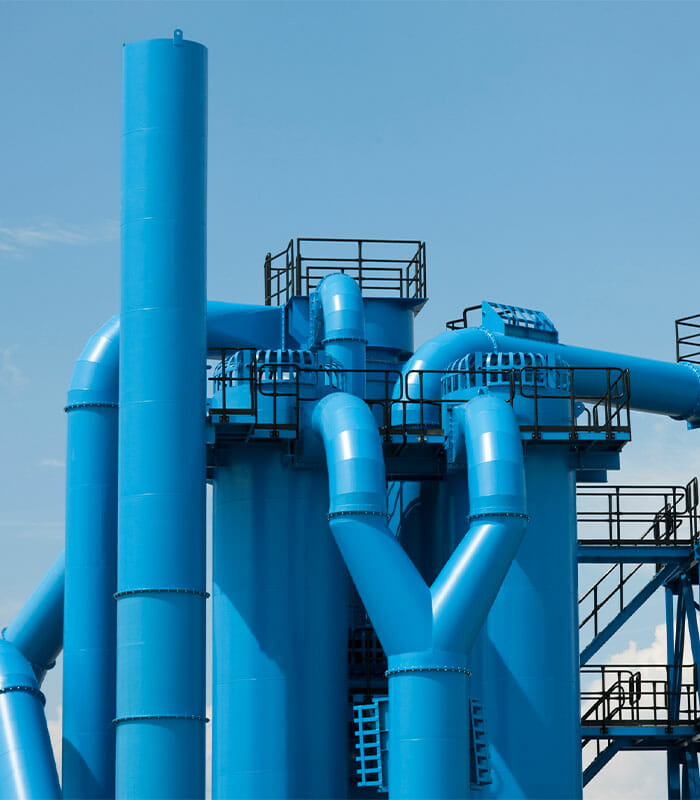Our Work
Carbon Capture
CATF’s work in carbon capture aims to achieve global net-zero emissions by midcentury.
CATF works towards this goal by developing and advocating for policies aimed at making carbon capture, removal, and storage technologies cost competitive with using unabated fossil fuels for power generation and for use in the industrial sector, globally. Our goal is to rapidly accelerate the adoption of carbon capture technologies to prevent the emission of millions of tonnes of CO₂ from power generation and industrial sources around the world.

Latest updates in carbon capture
Sign up today to receive the latest content from CATF experts.
Our impact in carbon capture
Our Efforts
The amount of carbon dioxide released globally from energy use is a staggering 26 billion tonnes. For power plants that will continue to use coal and natural gas, carbon capture can mitigate CO₂ emissions. Global industrial sources such as chemical, cement, iron, and steel production account for approximately one fifth of all CO₂ emissions, which cannot be mitigated through any other technology other than carbon capture and sequestration. Carbon capture can keep millions of tonnes of CO₂ emitted from these sources out of the atmosphere, making it a critical tool in the global climate solution toolbox. The individual technologies that comprise carbon capture have been commercially available for many decades but are only now being harnessed to address global warming.
CATF takes into account the role for carbon capture technology globally as modeled by the IEA and IPCC and works backwards to develop, evaluate, and implement a roadmap of policies that will allow the technology to scale, deploy globally, and deliver necessary CO₂ reductions to meet climate goals. CATF works to ensure that by 2030 carbon capture technologies will have achieved cost parity with unabated fossil and that policy pathways exist to help deploy carbon capture globally at a meaningful scale.
Scope of Work
- Policy Development & Advocacy: CATF advocates for policies, regulations, and incentives that would drive carbon capture deployment in both the power and industrial sectors and expand the existing network CO₂ pipelines and storage sites.
- Commercial Assessment & Support: CATF evaluates emerging technologies, promotes business partnerships that develop new projects, and supports plans to advance carbon capture hubs composed of pipeline and storage sites. CATF leads information sharing and business-to-business partnership-building through workshops and site tours.
- Carbon Capture Economics & Analysis: CATF conducts extensive research and modeling to understand the factors that impact CCS deployment including costs, market ecosystem barriers, and business models.
- Education and Outreach: CATF seeks to educate policy makers and stakeholders on the long-term carbon reduction benefits of carbon capture technology and to enable critical path policy choices that will enable the technology to play its part in achieving significant carbon reductions from the unabated use of fossil fuels. CATF has played a catalytic role in forming broad coalitions of support for carbon capture.
Achievements
U.S.
- CATF has been working towards the biggest proposed legislative package to commercialize carbon capture, removal, and storage technologies as included in the Biden-Harris Administration’s American Jobs Plan and introduced in Congress. This includes working towards an improved 45Q tax credit and the passage of the SCALE Act, the first ever CO₂ infrastructure and jobs bill, which would enable CO₂ storage commercialization. Read about the package in this factsheet.
- The carbon capture incentive that U.S. Congress adopted in February 2018, 45Q, is a milestone victory in advancing carbon capture technology. CATF had been working on this outcome for 10 years. CATF helped create the Carbon Capture Coalition, which includes both conservative and liberal stakeholders and advocates for carbon capture technology.
- CATF helped secure the adoption of federal reporting and accounting rules by EPA (subpart RR) for geologic storage that helps enable targeted incentives such as 45Q.
- CATF helped secure the adoption of federal standards under EPA’s Carbon Pollution Rule that requires new coal power plants to meet emission limits that are consistent with the use of carbon capture and storage technology.
- CATF led a modeling study with Charles River Associates showing the impact of 45Q and other proposed incentives on the deployment of carbon capture in the U.S. power sector. CATF’s analysis based on this study has been instrumental in communicating the impacts of potential incentives to policymakers and other stakeholders.
- CATF helped secure the DOE grants program that resulted in three active power and industrial CCS projects in North America.
Europe
- In Europe, CATF launched its Carbon Capture Program in Spring of 2021. Its current focus is on creating a supportive advocacy environment and educating stakeholders and lawmakers about the importance of carbon capture, removal, and storage technologies for climate neutrality.
- Together with environmental organization Bellona, CATF launched the #TenETuesday campaign to press for support for CO₂ transport modalities and geologic storage as part of the Trans-European Energy Infrastructure (TEN-E) reform. The campaign has raised awareness for carbon capture, removal, and storage, brought diverse voices from academia, science, industry, and advocacy into the discussion, and will serve as a segue for working towards an EU Carbon Capture, Removal, and Storage Strategy.
- CATF also launched its Europe Carbon Capture Project and Activity Tracker, making visible the vast private sector interest in deploying the technologies, despite the lack of political recognition and comprehensive policy.
China
- In China, CATF brought carbon capture and CO₂ EOR technology know-how and learning to China’s four largest oil companies and their regional subsidiaries. Our experts visited numerous regional Chinese carbon capture-related research and pilot project sites that are typically out of view of Westerners and have compiled project data and strategies to help those projects mature to commercial stage.
- We have also established an offshore carbon storage partnership between the Chinese Academy of Sciences in Guangdong and the University of Texas at Austin Gulf Coast Carbon Center, as well as a number of business-to-business partnerships between Chinese and U.S. companies. Finally, we’ve conducted six field study workshops for Chinese companies in Texas to learn about carbon dioxide management and pipeline design.
The importance of carbon capture
Carbon capture is an essential climate solution. CATF works towards making carbon capture widely available, enabling global energy system decarbonization.

Interactive CCS Map
Early-stage carbon capture projects around the world
CATF has built interactive maps that track carbon capture projects that have been publicly announced in the U.S., Europe, and the Middle East and North Africa (MENA). Users can click on the colored circles on each map to learn about each project’s location, sector (industrial, power, or direct air capture), type of CO₂ storage (EOR or saline), storage capacity and current status.
CCS Cost Tool
The cost of carbon capture and storage in Europe
This interactive tool provides an overview of the cost of carbon capture and storage in Europe, according to the location and characteristics of each emissions source. Use the tool to explore different scenarios for reducing the cost of CO₂ transport and storage, and to visualise the scale of the CO₂ abatement opportunity at different carbon price levels.

CO2 Storage Tracker
Tracking CO2 storage project capacity in Europe
Geological storage of CO₂ will need to be rapidly scaled up to help Europe meet its climate goals. This tracker shows the target annual and total capacities that have been publicly announced by CO₂ storage projects across Europe.
Current Projects
See what we’re working on
U.S. Federal Incentives
After helping secure the federal tax incentive for carbon capture in early 2018, CATF is now focused on enabling its implementation by engaging the U.S. EPA, U.S. treasury and potential sequestration project developers. CATF is also working to promote additional policies, including financial incentives for carbon capture and constantly analyzing policies that are under consideration before Congress, such as the Master Limited Partnership, Private Activity Bonds and other policies that will push carbon capture market ecosystem development by expanding pipeline infrastructure and developing carbon storage management entities. CATF’s macro-economic modeling, conducted using Charles River Associates’ North American Energy & Environmental Model, and analysis of carbon capture incentives supports policy strategy for the broader community of carbon capture advocates.
European Carbon Capture, Removal, and Storage Strategy
We are working in Brussels and beyond to help solve the challenges that the EU faces around the rapid scale-up and deployment of carbon capture technology that we need. With carbon capture and storage technologies proven, but not widely deployed, our focus is now on putting in place the right policy framework to deliver commercialization and CO2 transport and storage infrastructure. To this end, we work with NGO partners, educate other stakeholders, speak at and host events, encourage international collaboration, and work with governments and policymakers to develop strategies and policies for carbon capture deployment.
Policy certainty for the role of carbon capture technologies in a decarbonized future is needed, as well as harmonized endorsement for carbon capture, removal and storage as a carbon reduction method, so that industry can plan for widescale uptake. Policy needs to address both the development of at-scale CO₂ transport and storage infrastructure and provide capture technology deployment incentives for facilities to capture their carbon.
California Climate Programs
In September 2018, California committed to achieving economy-wide carbon neutrality no later than 2045 and then get to negative emissions. California also committed to a zero-carbon power grid by 2045. CATF is currently working closely with California Air Resources Board to enable inclusion of carbon capture technology in the state’s climate programs aimed to meet these ambitious goals.
China Information Sharing and Partnership Building
CATF has been working for a decade with colleagues in China to advance carbon capture technologies and know-how through regional technical exchange, workshops, U.S. study tours for Chinese companies, and business and academic institution partnerships.
Related resources
Meet our experts working in
carbon capture
-

Sam Bailey
Industrial Decarbonization Manager -

Sam Bowers
U.S. Policy Manager, Carbon Capture -

Ben Grove
Senior Manager, Carbon Storage -

Toby Lockwood
Technology and Markets Director, Carbon Capture -

Alan Masinter
Attorney -

Codie Rossi
Europe Policy Manager, Carbon Capture -

Eliza Sheff
Program Manager, Hydrogen and Carbon Capture -

John Thompson
Technology and Markets Director -

Darryle Ulama
Technology and Infrastructure Manager, Carbon Capture













